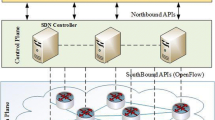Abstract
5G is anticipated in 2020. In this generation of mobile networks, a great deal of requirements have been set. Although, there are many strong technologies in the telecommunications’ sector they do not respond to the 5G goals. On the other hand, telecommunication operators and providers do not want to invest in new equipment/architectures. Cognitive radio (CR) and software defined networking are two technologies with special and vigorous advantages. In this paper, several technical and economic models are developed. The CR is combined with the Stackelberg game. A sensitivity analysis is implemented and the parameters that impact mostly on the model are pinpointed. It is shown that the CR technology could offer all its fundamental cognitive advantages and even financial profits to the telecommunication companies.



























Similar content being viewed by others
References
Description, M. K. (2017). Nolle: Cost per bit exceeds revenues. https://www.lightreading.com/business-employment/business-transformation/nolle-in-2017-cost-per-bit-exceeds-revenues/d/d-id/729446
Akyildiz, I. F., Nie, S., Lin, S.-C., & Chandrasekaran, M. (2016). 5G roadmap: 10 key enabling technologies. Computer Networks, 106, 17–48.
Sharma, P. (2013). Evolution of mobile wireless communication networks-1g to 5g as well as future prospective of next generation communication network. International Journal of Computer Science and Mobile Computing, 2(8), 47–53.
Smail, G., & Weijia, J. (2017). Techno-economic analysis and prediction for the deployment of 5g mobile network. In 20th Conference on innovations in clouds, internet and networks (ICIN) (pp. 9–16). IEEE.
Von Stackelberg, H. (2010). Market structure and equilibrium. New York: Springer.
Fomin, V. V., & Medeisis, A. (2015). Co-evolutionary analysis of cognitive radio systems. In Modern trends surrounding information technology standards and standardization within organizations (pp. 107–124). IGI Global. https://www.vdu.lt/cris/handle/20.500.12259/40861
Numan, P. E., Yusof, K. M., Suleiman, D. U., Bassi, J. S., Yusof, S. K. S., & Din, J. B. (2016). Hidden node scenario: A case for cooperative spectrum sensing in cognitive radio networks. Indian Journal of Science and Technology, 9(46). http://52.172.159.94/index.php/indjst/article/view/107145/76099
Medeisis, A., & Delaere, S. (2011). High-level scenarios for the future of cognitive radio business. In IEEE 22nd international symposium on personal indoor and mobile radio communications (PIMRC) (pp. 2330–2334). IEEE.
Barrie, M., Tytgat, L., Gonçalves, V., Yaron, O., Moerman, I., Demeester, P., Pollin, S., Ballon, P., & Delaere, S. (2011). Techno-economic evaluation of cognitive radio in a factory scenario. In International conference on research in networking (pp. 52–61). Springer.
Xie, R., Yu, F. R., Ji, H., & Li, Y. (2012). Energy-efficient resource allocation for heterogeneous cognitive radio networks with femtocells. IEEE Transactions on Wireless Communications, 11(11), 3910–3920.
Liang, Y. C., Chen, K. C., Li, G. Y., & Mahonen, P. (2011). Cognitive radio networking and communications: An overview. IEEE Transactions on Vehicular Technology, 60, 3386–3407.
Preet, A., Kaur, A., & Sahib, S. F. (2014). Review paper on cognitive radio networking and communications. International Journal of Computer Science and Information Technologies, 5(4), 5508–5511.
Haykin, S., et al. (2005). Cognitive radio: Brain-empowered wireless communications. IEEE Journal on Selected Areas in Communications, 23(2), 201–220.
Bouras, C., Kollia, A., & Papazois, A. (2017). SDN & NFV in 5g: Advancements and challenges. In 20th Conference on innovations in clouds, internet and networks (ICIN) (pp. 107–111). IEEE.
Bouras, C., Ntarzanos, P., & Papazois, A. (2016). Cost modeling for SDN/NFV based mobile 5g networks. In 8th International congress on ultra modern telecommunications and control systems and workshops (ICUMT) (pp. 56–61).
Author information
Authors and Affiliations
Corresponding author
Additional information
Publisher's Note
Springer Nature remains neutral with regard to jurisdictional claims in published maps and institutional affiliations.
Rights and permissions
About this article
Cite this article
Bouras, C., Kollia, A. & Maligianni, E. Techno-economic Comparison of Cognitive Radio and Software Defined Network (SDN) Cost Models in 5G Networks. Wireless Pers Commun 114, 1403–1430 (2020). https://doi.org/10.1007/s11277-020-07426-8
Published:
Issue Date:
DOI: https://doi.org/10.1007/s11277-020-07426-8




